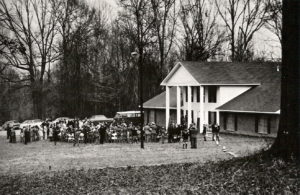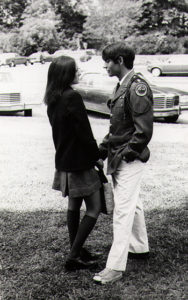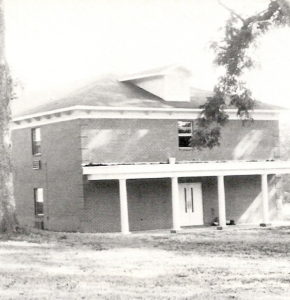 At the beginning of this period, two new buildings were completed, marking the capstone of the expanded mission the Academy assumed under President McKenzie’s leadership. A girl’s dormitory was dedicated in January of 1976 in honor of Mrs. Kathleen McKenzie. And a new dining hall was dedicated in July of 1977 in honor of Rev. Richard Bolling, an alumnus, a Presbyterian pastor, and a member of the Board of Trustees for over 30 years. The Academy’s facilities were thus ready to serve a large number of boys and girls, both boarding and day students.
At the beginning of this period, two new buildings were completed, marking the capstone of the expanded mission the Academy assumed under President McKenzie’s leadership. A girl’s dormitory was dedicated in January of 1976 in honor of Mrs. Kathleen McKenzie. And a new dining hall was dedicated in July of 1977 in honor of Rev. Richard Bolling, an alumnus, a Presbyterian pastor, and a member of the Board of Trustees for over 30 years. The Academy’s facilities were thus ready to serve a large number of boys and girls, both boarding and day students.
 During these years, the Academy was more integrated into the town of Port Gibson than ever before. Alumnus W.L. “Chip” Prehn describes it this way: “Tension completely ceased between ‘town and gown’ for the first time in decades. (In years past some of this tension had occasionally resulted in fist-fights on Main Street). During this time, many day students and boarders became very close friends. They hunted and fished together, drove Church Street on weekends, accompanied each other to football games and fraternity ‘recruiting’ parties in Oxford, Baton Rouge and elsewhere. They loved and admired each other. The local girls continued dating boys from all over the country. The student body was happy and alive.”
During these years, the Academy was more integrated into the town of Port Gibson than ever before. Alumnus W.L. “Chip” Prehn describes it this way: “Tension completely ceased between ‘town and gown’ for the first time in decades. (In years past some of this tension had occasionally resulted in fist-fights on Main Street). During this time, many day students and boarders became very close friends. They hunted and fished together, drove Church Street on weekends, accompanied each other to football games and fraternity ‘recruiting’ parties in Oxford, Baton Rouge and elsewhere. They loved and admired each other. The local girls continued dating boys from all over the country. The student body was happy and alive.”
But behind the scenes, all was not well. A series of Presidents came and went during these years, and constantly changing leadership made it difficult for the Academy to define and pursue its mission. From 1879 to 1975, the school had 12 leaders – from 1976 through 1997 it had ten more. In addition, and perhaps as a result of this lack of focus, the number of boarding students began to decline again during these years, as military schools fell out of fashion and as tightened budgets meant necessary repairs were put off. By the Fall of 1981, only one floor of Guthrie Hall was usable as a dormitory, and there were only 101 boarding students enrolled.
To remedy this situation, a new dormitory was constructed in the fall of 1983 in the hopes that more students would generate additional revenue. But the new dorm simply meant new indebtedness, while the number of boarding students remained at 101 in the fall of 1984. The dorm remained unnamed, as no donor stepped forward to pay for it. As a result of these and other expenditures, by the summer of 1985 the school owed almost half a million dollars. At that time, the endowment was exhausted to pay some of these debts.
By the late 1980’s, the school’s financial situation had become desperate enough for its real estate to be foreclosed on. Local businessmen including James Beesley, George Acker Hudson, and Ray John Forrest made significant contributions to the school, and Robert D. Gage IV provided critical financing. Under COL Russ Miller’s administration, important cost savings were realized and the school was stabilized. But Port Gibson wasn’t growing, and boarding students still didn’t find aging facilities and military discipline attractive.
By the beginning of school in 1997, CHA’s total enrollment was less than 100 students, and all of the boarding students could be housed in New Dorm. President Chris Johnson, an alumnus of both CHA and the US Military Academy at West Point, was determined to turn things around, and asked the new Pastor of First Presbyterian Church in Port Gibson to help him make Christian soldiers. Rev. Michael Herrin began volunteering at CHA, teaching a Bible class to the seniors and leading chapel worship. But the Board knew that more resources were needed if the Academy was to survive, so they began conversations with French Camp Academy, a thriving Christian school in North Mississippi, to help out.